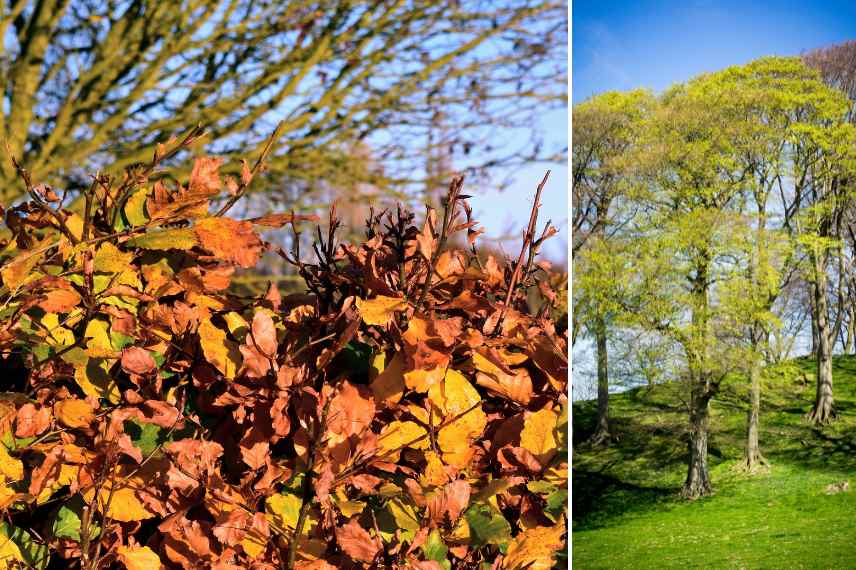Common beech or Fagus sylvatica is a majestic tree rarely chosen as a specimen tree in the garden. Admittedly, it is large and handsome but... a little cumbersome. Fortunately, smaller cultivars, such as the purple weeping beech, some beech with fastigiate habit or even dwarf varieties, can be adopted in our modest green spaces. But common beech also tolerates repeated pruning remarkably well, which makes it perfect for a clipped hedge. Another way to bring this forest tree into the garden. Discover in this tutorial when and how to prune a specimen beech or a beech hedge?

When to prune beech?
Beech is pruned from November to December or from February to late March, but always outside periods of frost.
For maintenance pruning of a hedge, carry out work in late June, then around September.
My tip: be sure to disinfect your cutting tools and ensure they are well sharpened! Disease can spread so quickly in beeches…
How to prune a beech?
Formative pruning
When young, remove misplaced branches and lower branches gradually to raise the crown and gradually reveal its trunk.
Later on
For a beech intended as a specimen tree, it is better to intervene as little as possible. Only remove dead wood, crossing branches and those growing along the trunk.
A transparency pruning is perfect for aesthetics while respecting the tree. To learn more, read pruning trees for transparency.
For older, therefore large, specimens, call a professional tree surgeon!
Some cultivars of Fagus sylvatica or common beech require no pruning at all. This is the case for the dwarf beech or Fagus sylvatica 'Mercedes', which will not exceed 2 m in height, or certain beech with fastigiate habit, such as Fagus sylvatica 'Dawyck Gold'.
Note: beech can also be worked using the ancestral technique known as "pollarded tree".

Special case: beech hedge
Like the common hornbeam, common beech tolerates pruning admirably and has marcescent foliage (dead leaves remain attached to branches during winter). These two qualities make it valuable for forming clipped hedges.
In theory, pruning can be done all year to maintain clean lines. In general, it is recommended to start with a cut in late June then complete it with a second cut between August and September. The operation is carried out with a hedge trimmer or a shear.
Remember that the hedge should be slightly wider at the base than at the top. This allows lower leaves to continue benefiting from sunlight.
please note : at planting, you can cut back young beeches to about twenty centimetres above soil. This encourages them to branch from the base, producing a denser hedge. However, growth rate is strongly slowed. Along the same lines, you can rejuvenate a slightly bare beech hedge by the same operation. This pruning should be done at the end of winter (February–March) to benefit all winter from marcescent foliage and to work before new leaves form.

Necessary equipment
- Pruning shears
- Loppers or pruners
- Cut-resistant gloves and safety goggles
- For hedge trimming: a manual hedge trimmer (shear) or powered (electric or petrol)
- Possibly a ladder or a small garden scaffold.































![[pruning type="article" plant="beech"]
In order to maintain a beech tree's shape and health, it is essential to prune it regularly. The best time to prune a beech tree is during the dormant season, which typically falls between late autumn and early spring. Avoid pruning during the growing season to prevent excessive sap loss.
When pruning a beech tree, focus on removing dead, damaged, or diseased branches first. Next, you can proceed with thinning out the canopy to improve air circulation and allow more light to penetrate the tree. Be sure to use sharp and clean pruning tools to make precise cuts and minimize the risk of infection.
By following these pruning guidelines, you can help your beech tree thrive and maintain an attractive appearance in your garden. Pruning Beech, Fagus sylvatica](https://www.promessedefleurs.ie/blogwp/wp-content/uploads/2023/03/Comment-et-quand-tailler-le-hetre-.png)
Comments